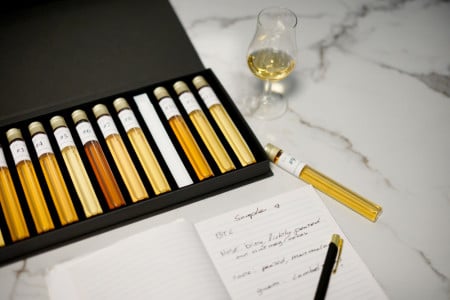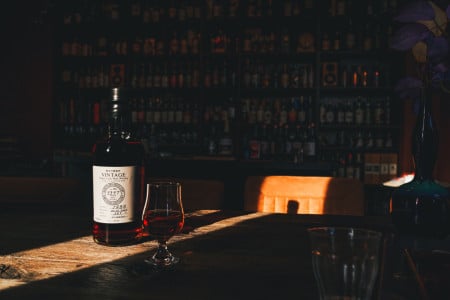It is one of the most famous Bordeaux wine estates of all and regularly causes a sensation with its equally long-lived, dense and complex wines. We are talking, of course, about Château Latour. But why does Château Latour's First Growth have such cult status? Who does it belong to? And what are the best vintages? We will now take a look at all these questions and more.
1. Where is Château Latour located?
On the left bank of the Gironde, in the Bordeaux region of Médoc, is the Pauillac appellation, which covers just 900 hectares of vineyards. Here, in the far north-east, virtually on the border with the Saint-Julien appellation, you will find Château Latour with its 80 hectares of vineyards. The heart of the estate is clearly the almost 50-hectare l'Enclos vineyard, which lies only 300 metres from the banks of the Gironde and is completely surrounded by a stone wall that creates a very special microclimate. The soils here are characterised by gravel. An ideal subsoil - especially for Cabernet Sauvignon. This grape variety makes up the majority of the planting (75 percent), followed by 20 percent Merlot, four percent Cabernet Franc and one percent Petit Verdot.
2. How did Château Latour get its name?
In Bordeaux, it has always been customary for a vineyard to be named after its owner. But Château Latour is actually an exception here. The land that belongs to the winery today was already used for agriculture in the early 14th century. In order to better protect themselves from attacks from the river during the Hundred Years' War, a fortress tower was built on this very land in the late 14th century, which was called La Tour en Saint-Maubert. And it was from this that Alexandre de Ségur derived the name of the winery in 1716, when he officially founded it. Château Latour.
3. Does the tower still exist?
Unfortunately, the 14th century fortress tower no longer exists. If it still existed, by the way, it would now be standing directly in the sea of vines of the site l'Enclos. But in the early 17th century, a round tower was built on the estate that would later become Château Latour, and it was christened La Tour de Saint-Lambert. Even then, however, the tower with its round dome was not quite as visually attractive as the original. That is why a picture of the old tower still adorns the label of the bottles.
4. What is special about the Grand Vin of Château Latour?
Château Latour's Grand Vin is generally considered to be one of the densest, most complex and longest-lived red wines in the world. In fact, this First Growth needs at least 15 years before it even develops its full potential. This is due not only to the high proportion of Cabernet Sauvignon, which dominates the cuvée by at least 90 per cent, but also to the sophisticated barrique ageing.
As a result, even older vintages present themselves with an impressive liveliness. On several occasions, we tasted some older vintages of Latour. The 1928 is still a wine at its best. The 1959 and the 1961 can last at least another 10-20 years, decanting is even recommended here.
Chateau Latour meets elegance even in small vintages. No wonder that this wine regularly receives high points from international wine critics. Robert Parker alone awarded the legendary and rare 100 points several times for his Wine Advocate!
5. Why is the Grand Vin from Château Latour so famous and expensive?
One might think that the success of Château Latour began in 1855. At that time, on the occasion of the World Exhibition in Paris, the classification of particularly outstanding Bordeaux wine estates in the Médoc, which is still valid today, took place. Château Latour was one of only four wineries to receive the status of Premier Cru Classé. The fact is, however, that the winery was already a world-famous legend at that time. It owes this fact to none other than Thomas Jefferson. The passionate wine connoisseur and later president of the United States confirmed the wines of Château Latour in a letter dated 24 May 1787 as Premier Cru. In other words, long before this classification was even introduced. And although Château Latour ranked somewhat behind Château Lafite in terms of esteem and prestige at that time, it did not change the fact that this praise alone ensured that Latour wines were twenty times more expensive than other Bordeaux growths around the year 1800.
But even today, Château Latour knows very well how to cultivate its own famous image - and to profit from covetousness. According to their own information, they have been putting aside about 40 per cent of their Grand Vins since 2005, in order to bring them to the market later on when they have matured. At the appropriate price, of course. With an annual production of 300,000 bottles, that's 120,000 bottles per year that are stored in the winery's vaulted cellars.
6. How does Château Latour manage its vineyards?
Unnoticed by the public, Château Latour converted its cultivation from conventional to biodynamic a few years ago. Instead of the chemical club, horn silica, dynamised compost and nettle tea are now the trump cards in the vineyards. By the way, they deliberately did not give this information to the wine press after the conversion, because they did not want to misuse the idea of sustainability behind it as a marketing tool. Very honourable indeed.
Château Latour is now a pioneer in biodynamics in Pauillac. However, the pioneer status is not new to the winery. As early as the 1960s, the estate took a courageous step forward by deliberately avoiding wooden fermentation vats and instead relying on stainless steel tanks, which were to become the norm throughout Europe only 20 years later.
7. What is special about the second wine Forts de Latour?
Normally in Bordeaux, grapes from parcels with young vines are used for the second wine. Not so at Château Latour. Here, they only use grapes from plots that lie outside the stone walls of l'Enclos. These areas were deliberately purchased for the second wine, Forts de Latour, which was first vinified in 1966. Here, too, Cabernet Sauvignon dominates. However, only with at least 70 instead of 90 percent. By the way, fermentation and ageing are identical to the Grand Vin. It is therefore not surprising that the Forts de Latour is also convincing with its deep complexity and elegance.
8. Is there also a third wine from Château Latour?
With the Pauillac de Latour, a third wine was created at Château Latour in 1990. This is where the young vines from the l'Enclos vineyard finally come into play. Because these are used here. But that sounds easier than it actually is. The vines in l'Enclos are on average 60 years old - but some have been there for over 100 years. Normally, wineries plant new vines parcel by parcel. Namely, whenever too many vines in a plot are too sick, too old or perhaps even already dead. But that's exactly what they don't do at Château Latour. As soon as a vine in l'Enclos weakens, it is immediately replaced. A measure that is as elaborate as it is unprecedented. This also means that the harvest workers for the third wine, Pauillac de Latour, have to cover a lot of ground during the harvest. For this wine, individual vines are harvested very specifically!
9. Who owns Château Latour?
It is astonishing that Château Latour - at least by Bordeaux standards - has remained in the hands of a single family for so long. Namely the de Ségur family. Even more astonishing: immediately after its foundation in 1716, Alexandre de Ségur also bought Château Lafite. However, he didn't have much pleasure in the double reputation, because he died a short time later. It was his son Nicolas-Alexandre de Ségur who bought Château Mouton and Château Salon. It was thanks to him that not only the British Prime Minister Robert Walpole but also King Louis XV enjoyed the wines of his estates. A circumstance that earned him the nickname "Prince des vignes" - "Prince of the Vines".
In 1963, the Ségur heirs sold 75 percent of their shares to the two British companies Harveys of Bistros and the Person Group. In 1989, the property then changed hands to Allied Lyons, before returning to French hands in 1993, when François Pinault acquired Château Latour. The estate thus became part of his luxury goods group Pinault-Printemps-Redoute (PPR), which also owns brands such as Gucci and Puma. Fun Fact: If Pinault ever wants to sell Château Latour again, it will only be to a Frenchman. As a Premier Cru Classé, the vineyard now has the status of a national treasure in France - and therefore may not be sold to foreigners.
10. What are the best vintages?
Of course, this is a question that is difficult to answer objectively, as every wine lover has their preferences. But there are, of course, vintages that clearly stand out.
Chateau Latour's best vintages are: 1928, 1959, 1961, 1982, 1996, 2000, 2009, 2010, 2016, 2018, 2020
Robert Parker gives 100 points to 1961, 1982, 2009, 2010, 2016, 2018.





